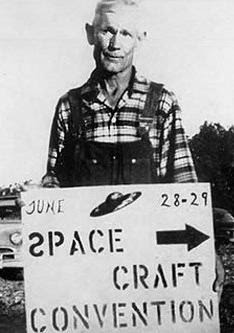by Charles Lear
 The year 1957 was a very interesting one in UFO history. In that year, UFO occupant reports were accepted as worthy of investigation by serious organizations such as the Aerial Phenomena Research Organization and Civilian Saucer Intelligence of New York; Contactees were in the spotlight thanks to the Long John Nebel Show; and Maj. Donald Keyhoe USMC ret. became the director of the National Investigations Committee on Aerial Phenomena. The main question in the early days of flying saucers had been whether or not they came from outer space. The Air Force had assured the public that they were working to find the answers to the mystery, but now the public’s faith in the Air Force was waning and the mystery was more complex. Who to believe and what to believe were now complicated by competing factions and commercial interests. A person could get in there and diligently research and investigate, sit back and enjoy the circus or join the circus and cash in.
The year 1957 was a very interesting one in UFO history. In that year, UFO occupant reports were accepted as worthy of investigation by serious organizations such as the Aerial Phenomena Research Organization and Civilian Saucer Intelligence of New York; Contactees were in the spotlight thanks to the Long John Nebel Show; and Maj. Donald Keyhoe USMC ret. became the director of the National Investigations Committee on Aerial Phenomena. The main question in the early days of flying saucers had been whether or not they came from outer space. The Air Force had assured the public that they were working to find the answers to the mystery, but now the public’s faith in the Air Force was waning and the mystery was more complex. Who to believe and what to believe were now complicated by competing factions and commercial interests. A person could get in there and diligently research and investigate, sit back and enjoy the circus or join the circus and cash in.
The editorial in the May, 1957 CSI News Letter No. 19, “The Price of Being Too Factual,” encapsulates the state of UFOlogy at that time. It begins with the announcement that Leonard Stringfield will no longer be issuing the periodical Orbit. This was the newsletter for his organization, Civilian Research Interplanetary Flying Objects. Stringfield had a reputation for being a no-nonsense investigator and was a trusted source for sightings reports. That he was unable to cover his printing costs while a “tongue-in cheek entertainer,” like John Nebel, and “a purveyor of a gospel,” such as George Adamski, were able to maintain a mass audience is noted as boding “ill for the future of UFO research.” Providing hope is the news that NICAP is under new management and the writer ends by encouraging readers to support the organization and that “it’s time to put up or shut up.”
NICAP was founded in 1956 by T. Townsend Brown, who claimed to have developed an anti-gravity device. Keyhoe had been instrumental in recruiting many prominent people, including Rear Adm. Delmar C. Fahrney USN ret., to sit on NICAP’s board of governors. NICAP had lofty ambitions and having a paid, full-time staff was one of them. An $85,000 a year payroll for that staff, which included Brown, was “suggested” and an argument ensued that resulted in Brown leaving and Keyhoe taking over as director. Read more →
 In the late 1950s flying saucers had been in the public consciousness for about a decade. The shock of the Arnold sighting and UFOs over Washington DC had worn off; saucers, though still mysterious, were now familiar. The government was actively running its third investigation into the reports of unidentified flying objects. Hollywood was incorporating the now iconic saucer craft into films of all budgets. Books had been printed on saucers and UFO magazines were on the newsstands every week. A new culture was being born around the flying saucers and possibility of alien contact. Many people claimed to have been contacted by extraterrestrials and some even claimed to have ridden in their craft. Others maintained that they had been given messages for their fellow Earthlings from the Space Brothers or comely Venusians.
In the late 1950s flying saucers had been in the public consciousness for about a decade. The shock of the Arnold sighting and UFOs over Washington DC had worn off; saucers, though still mysterious, were now familiar. The government was actively running its third investigation into the reports of unidentified flying objects. Hollywood was incorporating the now iconic saucer craft into films of all budgets. Books had been printed on saucers and UFO magazines were on the newsstands every week. A new culture was being born around the flying saucers and possibility of alien contact. Many people claimed to have been contacted by extraterrestrials and some even claimed to have ridden in their craft. Others maintained that they had been given messages for their fellow Earthlings from the Space Brothers or comely Venusians. The year 1957 was a very interesting one in UFO history. In that year, UFO occupant reports were accepted as worthy of investigation by serious organizations such as the Aerial Phenomena Research Organization and Civilian Saucer Intelligence of New York; Contactees were in the spotlight thanks to the
The year 1957 was a very interesting one in UFO history. In that year, UFO occupant reports were accepted as worthy of investigation by serious organizations such as the Aerial Phenomena Research Organization and Civilian Saucer Intelligence of New York; Contactees were in the spotlight thanks to the